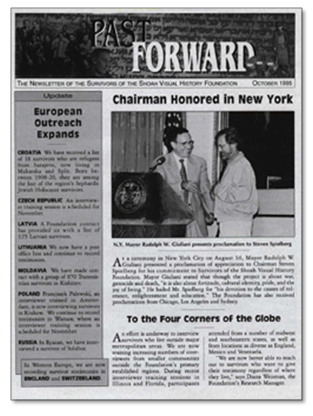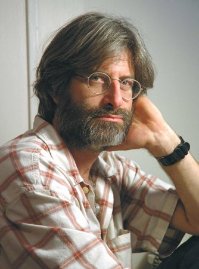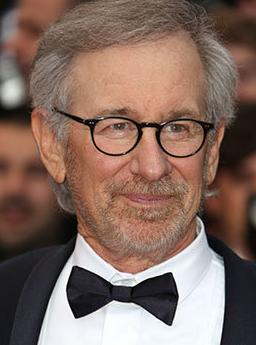
How to Shoot 64 Documentaries a Day
Published in Past Forward, the newsletter of Shoah Visual History Foundation. Writer/Editor: Warren Goldie. Chairman: Steven Spielberg

Mike Engel
Mike and the Production team begin their day at 6 a.m., checking in with the worldwide regional offices to ensure that the project’s complex logistical challenges are being met. The department schedules interviews in more than 20 countries, deals with financial and legal issues in multiple languages, processes mountains of paperwork and troubleshoots issues that could interfere with the taping of Holocaust survivor testimonies.
“My job is to make sure the interviews happen … period,” says Mike. “That involves checking in with Paris, Amsterdam, Sydney, Toronto, the U.S and Eastern Europe. The challenge is keeping all the balls in the air without dropping any.”
Mike manages not only the project’s 225 videographers, but also the high-tech tape transfer and collection management operations that duplicate and preserve the testimonies for future generations.
A veteran filmmaker who has worked on documentaries, movies, corporate films and TV commercials, Mike is nevertheless awed by the scope of this project. “Essentially, we’re shooting 64 documentaries a day for 750 days. That’s mind-boggling when you consider that the shooting schedule for the average film is 8-12 weeks.”

Chairman Spielberg
In fact, the setup for taping the testimonies is more complex than standard film production, which is due to the involvement of so many countries and the overall length of production.
“Filmmaking is more consistent and pattern-like,” explains Mike. “But this project keeps growing with new challenges. For example, how do we find a cameraman in Odessa? Okay, we locate two, but neither one speaks English. What then? My motto has always been ‘There’s got to be a way.’ That’s what we do. We find the way.”
Like many of his co-workers, Mike was drawn to the project for personal reasons. “My grandfather left Poland in 1939. He was among just 10,000 Jews admitted to Canada. I lost family members to the Holocaust.”
Mike’s family eventually settled in Los Angeles, though the Old Country remained close at hand. Says Mike, “My father was a philosophy professor and translator of Yiddish Holocaust literature. He kept the traditions going.”
How does Mike handle the responsibility of running an international production that’s always running against the clock — most survivors are in their 70s and 80s, and once they pass, their stories will be lost — to capture the crucial testimonies? “I love the responsibility,” he says. “I sleep when I can. Otherwise, I’m at work as much as I can be.”
Communications within Production’s global family almost always happen by phone or e-mail. Some regional staff don’t even know what Mike looks like, nor any of the other personnel in the Los Angeles home office.
If you happen to be one of these people visiting our offices on the Universal Studios back lot, please be sensitive to Mike. Don’t tell him he looks like a certain somebody. He already knows.
